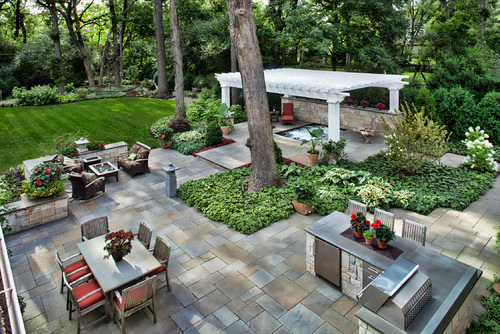You want your landscaping to provide functional spaces such as an entertainment area, a children’s play area or a vegetable garden.
Landscaping can also provide functional purposes such as erosion control, privacy or shade or warmth for the house. Many people install plants and landscapes and never think of the maintenance needs they will require.

Photo by Hursthouse Landscape Architects and Contractors – Look for patio pictures
Let’s see some easy tips to keep your landscape healthy no matter what the season.
The choice of irrigation systems and techniques has great impact on the efficiency of water use.
Benefits of efficient water use, besides a lower water bill, include a healthier garden and less work.
1/ Adjust sprinkler heads so they don’t spray walls, driveways or sidewalks.
2/ Water early in the morning when there is little or no wind and minimal sunlight. Don’t waste water. Do not water or water slowly your landscape in windy days. High winds blow away the water and prevent proper coverage.
3/ Check the sprinkler system weekly and immediately replace broken or missing sprinklers with identical parts.
4/ Change automatic irrigation system settings to reflect the season. When it is raining, you should turn the system off.
5/ For best results, shoot for “head-to-head” coverage. That means the spray of one sprinkler should reach the head of the sprinkler closest to it.
6/ Apply organic mulch around all shrubs and trees. Mulch reduces evaporation loss, minimizes weeds, and adds organic matter to the soil. Don’t forget to reapply mulch once it has broken down.
7/ Water areas in the shade about 30 percent less than sunny areas.
8/ Deep soak your lawn. When you do water your lawn, does it just long enough for water to seep down to the roots, where it won’t evaporate quickly, and where it will do the most good. A light sprinkling, which sits on the surface, will simply evaporate and be wasted. A slow, steady fall of water is the best way to irrigate your lawn.
9/ Use a drip irrigation system to water trees and shrubs and water appropriately. Experts agree that running drip irrigation less frequently is much better for plants than daily watering.
10/ Use separate irrigation valves for each type of planting so individual scheduling is possible. If the pressure in your area is high, install a pressure regulator to reduce water usage, and minimize sprinkler problems. Adjust your sprinkler system for different watering requirements due to exposure, shade and sprinkler output.
Plants for Dry Areas | Desert Landscaping – Tips and Ideas (howtobuildahouseblog.com)


